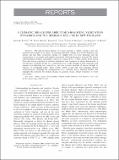A Climatic Driver for Abrupt Mid-Holocene Vegetation Dynamics and the Hemlock Decline in New England

View/
Author
Hansen, Barbara
Published Version
https://doi.org/10.1890/0012-9658(2006)87[2959:ACDFAM]2.0.CO;2Metadata
Show full item recordCitation
Foster, D. R., Oswald, W. W. , Faison, E. K. , Doughty, E. D. , Hansen, B. C. S. 2006. A climatic driver for abrupt mid-Holocene vegetation dynamics and the hemlock decline in New England. Ecology 87: 2959-2966.Abstract
The mid-Holocene decline of eastern hemlock is widely viewed as the sole prehistorical example of an insect- or pathogen-mediated collapse of a North American tree species and has been extensively studied for insights into pest–host dynamics and the consequences to terrestrial and aquatic ecosystems of dominant-species removal. We report paleoecological evidence implicating climate as a major driver of this episode. Data drawn from sites across a gradient in hemlock abundance from dominant to absent demonstrate: a synchronous, dramatic decline in a contrasting taxon (oak); changes in lake sediments and aquatic taxa indicating low water levels; and one or more intervals of intense drought at regional to continental scales. These results, which accord well with emerging climate reconstructions, challenge the interpretation of a biotically driven hemlock decline and highlight the potential for climate change to generate major, abrupt dynamics in forest ecosystems.Terms of Use
This article is made available under the terms and conditions applicable to Other Posted Material, as set forth at http://nrs.harvard.edu/urn-3:HUL.InstRepos:dash.current.terms-of-use#LAACitable link to this page
http://nrs.harvard.edu/urn-3:HUL.InstRepos:30676636
Collections
- FAS Scholarly Articles [18292]
Contact administrator regarding this item (to report mistakes or request changes)


